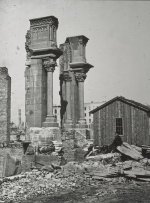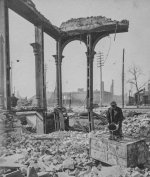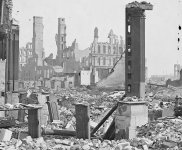This could probably be the biggest cover up in the history of mankind. At the same time, it could be a case of the mind boggling stupidity. I will present the facts, and you be the judge of which one it is. One way or the other, this bizarre occurrence could be classified as a historical anomaly.
I probably need to stop right here, and present my position right away. And this position is ridiculous, and improbable within the constraints of the today's science and history. Whether it is impossible could only be revealed through the in depth research by individuals with proper resources, skills, and levels of access.
To gain your immediate attention I will post a few pictures of the aftermath of the 1871 Great Chicago Fire. Inspect those pictures, and be honest with yourself. What kind of fire destroyed those concrete, and brick and mortar buildings without any trace of the fire damage? How could those trees and utility poles survive? What fire can cut three concrete blocks vertically in a straight line? Why were the structures reduced to single bricks, and dust?
An additional topic to think about are the structures themselves. What did the above buildings look like before they got destroyed? The remnants look more like ruins of some 1893 World's Columbian Exposition. Yet, we are being told that primarily wooden structures were destroyed.

1893 Chicago
The War of the Civilizations I think there was a devastating global war which took place in the 19th, or early 20th century. Time frame is somewhat of an unknown entity, while the similarity of events suggests that chronological spread could be artificial.
It remains to be determined whether our Planet was attacked from the outside, or it was an internal war fought on the Global scale. These are the only two scenarios I could come up with after my little amateur research. These scenarios bring along two distinctive developments:
1788 Great New Orleans Fire, "Officials were to replace the wooden buildings with masonry structures which had, thick brick walls, arcades, and wrought iron balconies"
1802 Great Portsmouth Fire, "As a result of the fire, the town voted to request state legislation banning wooden structures one story high within the town limits."
1835 Great New York Fire, "The destroyed wooden buildings were quickly replaced by larger stone and brick ones that were less prone to burn."
1871 Great Chicago Fire, "Authorities believed that with brick walls, the deaths and damage caused would have been much less."
1889 Great Seattle Fire, "A new building ordinance resulted in a downtown of brick and stone buildings, rather than wood"
1914 Great Salem Fire, "Salem Councilman, introduced an order that would have required all new or replacement roof coverings to be non-combustible."
In the 1871 Chicago case, I am not quite sure what wooden buildings they are talking about. Do you see any on this pre-fire schematic?

Than again, I think the above image is all fake. First of all it is not adequately representing the destroyed buildings. For if you do some research into the 1868 Chicago architecture, there might be a surprise waiting for you.
URBAN FIRESWhat we have is hundreds, may be thousands of Urban Fires destroying huge chunks of 18th, 19th and early 20th century cities through out the world. It is very hard to find a city which did not suffer this fate. Chicago, Toronto, New York, Seattle, Montreal, Boston, Pittsburgh, Philadelphia, Sydney,, Moscow, Wellington, Salzburg, Detroit, Lisbon, New Orleans, etc, etc, etc...
My list of the Urban Fires presented below was put together fairly quickly. I did not try to identify every single "Fire" which fits the profile. There were hundreds of additional Urban Fires out there. I live in the US, and Google was obviously region-guiding my search. In reality, no matter what continent you are on, if you have a 200-300 year old city, it most likely suffered one of those fires. The list below, is just a tip of the iceberg.
[Additionally we have devastating floods, earthquakes, hundreds of smaller scale "independence" wars, and the industrial revolution, happening simultaneously with the great after-urban fire rebuilding efforts]
These "Urban Fires" share some traits of striking similarity. These traits give up certain and undeniable relationship between all those fires.






1. Devastating damages done to the brick and mortar / concrete buildings









2. Lack of distinctive fire damage signature on the collapsed structures
Today fire aftermath looks like this


3. Presence of the bizarre diagonal wall cuts




4. Trees and wooden utility poles did not really burn
Sometimes even foliage survived the "fire"






5. Often ridiculously insignificant levels of the loss of human life, or the information is not present
(the below are some of the most compelling, impossible numbers)1842 – Hamburg Fire - 51 killed. 1/4 of the inner city destroyed, and an estimated 20,000 homeless
1845 - Pittsburgh Fire - 2 killed. The fire destroyed as many as 1200 buildings.
1871 - Chicago Fire - 120 killed. Destroyed were 17,500 buildings more than 73 miles (117 km) of roads, 120 miles (190 km) of sidewalk.
1872 - Boston Fire - 76 killed. Destroyed 776 buildings.
1889 - Seattle Fire - 0 killed. Up to 64 city blocks destroyed in the Fire.
1889 - Great Bakersfield Fire - 1 killed. Destroyed 196 buildings.
1901 - Jacksonville Fire - 7 killed. 146 city blocks, destroyed more than 2,368 buildings.
1916 - Paris, Texas Fire - 3 killed. 1,400 buildings destroyed.
 1906 San Francisco alone lost 28,000 buildings, 1871 Chicago lost 17,500 buildings. You can imagine the overall results.
1906 San Francisco alone lost 28,000 buildings, 1871 Chicago lost 17,500 buildings. You can imagine the overall results.
SUMMARY: while we are being told that mostly wooden structures were damaged, or destroyed, photographic evidence (whatever little we have) suggests otherwise. It is notable that structures destroyed look very similar to the ones in the article "Similar style buildings are all over the world. Were they built by our civilization?" It is hard to imagine that it took our civilization 150 years to figure out that wood burns. At the same time today's residential districts in the United States are nothing but plywood.
Separately, the so-called "Urban Fire" damages raise questions. I personally still want to know what "fire" was able to cut three of the below blocks in half.
Could Herbert George Wells know something back in 1897? What about Mike Brunton in 2015?
I probably need to stop right here, and present my position right away. And this position is ridiculous, and improbable within the constraints of the today's science and history. Whether it is impossible could only be revealed through the in depth research by individuals with proper resources, skills, and levels of access.
To gain your immediate attention I will post a few pictures of the aftermath of the 1871 Great Chicago Fire. Inspect those pictures, and be honest with yourself. What kind of fire destroyed those concrete, and brick and mortar buildings without any trace of the fire damage? How could those trees and utility poles survive? What fire can cut three concrete blocks vertically in a straight line? Why were the structures reduced to single bricks, and dust?
An additional topic to think about are the structures themselves. What did the above buildings look like before they got destroyed? The remnants look more like ruins of some 1893 World's Columbian Exposition. Yet, we are being told that primarily wooden structures were destroyed.
1893 Chicago
The War of the Civilizations
It remains to be determined whether our Planet was attacked from the outside, or it was an internal war fought on the Global scale. These are the only two scenarios I could come up with after my little amateur research. These scenarios bring along two distinctive developments:
- Internal War - would mean the destruction of the architectural signature of the previous advanced civilization present through out the world on the scale beyond explainable. The purpose of such an attack would be to erase this signature, and to bring it to the levels manageable by the dogmatic science. Why we are not supposed to know about that civilization is a million dollar question. There are multiple possibilities of Biblical proportions.
- Outside Attack - would suggest that the previous civilization was annihilated by some unknown forces. If it was indeed the case, than our current civilization could be that occupational force. Whether we are the "bad guys" I do not know, but this possibility definitely comes to my mind.
Human Incompetence
This possibility is way more convenient for the dogmatic way of thinking. Yet it makes the civil engineers of the past sound highly incompetent, and border line dumb and stupid. It is obvious that contributing factors of the devastating fires stayed the same for approximately 150 years. An attentive person would probably ask a reasonable question of why these bad experiences of the neighboring cities were widely ignored when new cities were getting constructed. Below is just an example of corrective actions to be taken by the burnt cities to prevent the fires from happening again. In reality this corrective action would be the same for just about every single urban fire within approximately 150 years.1788 Great New Orleans Fire, "Officials were to replace the wooden buildings with masonry structures which had, thick brick walls, arcades, and wrought iron balconies"
1802 Great Portsmouth Fire, "As a result of the fire, the town voted to request state legislation banning wooden structures one story high within the town limits."
1835 Great New York Fire, "The destroyed wooden buildings were quickly replaced by larger stone and brick ones that were less prone to burn."
1871 Great Chicago Fire, "Authorities believed that with brick walls, the deaths and damage caused would have been much less."
1889 Great Seattle Fire, "A new building ordinance resulted in a downtown of brick and stone buildings, rather than wood"
1914 Great Salem Fire, "Salem Councilman, introduced an order that would have required all new or replacement roof coverings to be non-combustible."
In the 1871 Chicago case, I am not quite sure what wooden buildings they are talking about. Do you see any on this pre-fire schematic?
URBAN FIRES
My list of the Urban Fires presented below was put together fairly quickly. I did not try to identify every single "Fire" which fits the profile. There were hundreds of additional Urban Fires out there. I live in the US, and Google was obviously region-guiding my search. In reality, no matter what continent you are on, if you have a 200-300 year old city, it most likely suffered one of those fires. The list below, is just a tip of the iceberg.
[Additionally we have devastating floods, earthquakes, hundreds of smaller scale "independence" wars, and the industrial revolution, happening simultaneously with the great after-urban fire rebuilding efforts]
These "Urban Fires" share some traits of striking similarity. These traits give up certain and undeniable relationship between all those fires.
- Devastating damages done to the brick and mortar / concrete buildings
- Lack of distinctive fire damage signature on the collapsed structures
- Presence of the bizarre diagonal wall cuts
- Trees and wooden utility poles did not really burn
- Often ridiculously insignificant levels of the loss of human life, or the information is not present
- Presence of similar people posing for "trophy-like" pictures
- Lack of photographic evidence of the clean up activities
- Super fast rebuilding activities
- Lack of photographic evidence of the rebuilding activities
- Presence of the signs announcing future project to be executed at a specific location
- Presence of the non-researchable, dead-end "appointed" architects
- Presence of the non-researchable buildings
- Bizarre fire initiating stories
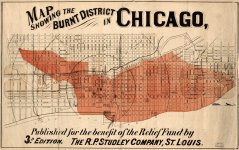
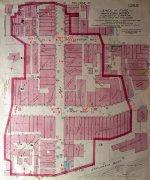
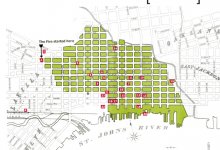
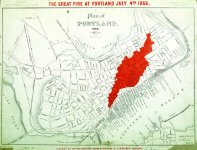
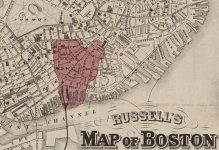
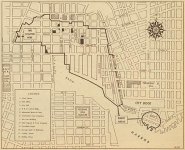
1. Devastating damages done to the brick and mortar / concrete buildings
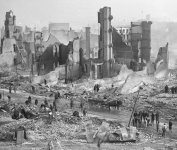
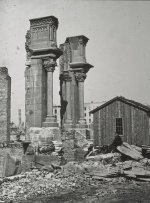
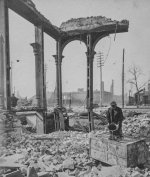
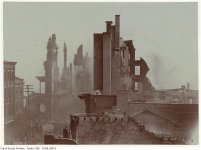
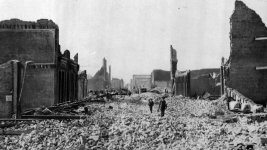
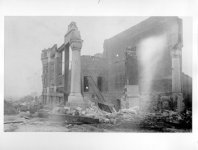
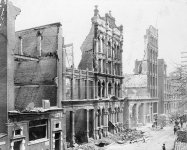
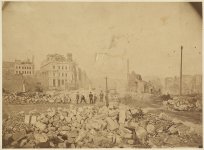
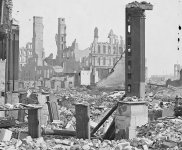
2. Lack of distinctive fire damage signature on the collapsed structures
Today fire aftermath looks like this
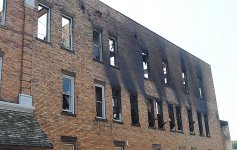
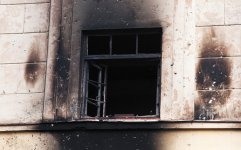
3. Presence of the bizarre diagonal wall cuts
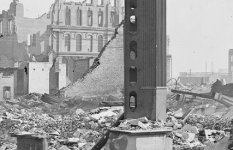
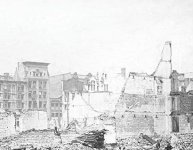
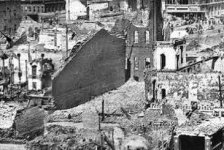
4. Trees and wooden utility poles did not really burn
Sometimes even foliage survived the "fire"
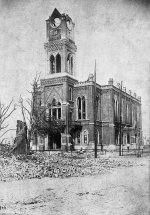
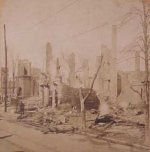
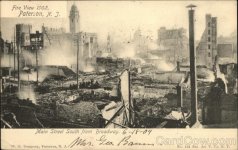
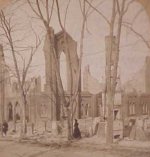
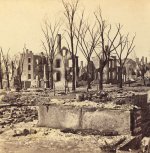
5. Often ridiculously insignificant levels of the loss of human life, or the information is not present
(the below are some of the most compelling, impossible numbers)
1845 - Pittsburgh Fire - 2 killed. The fire destroyed as many as 1200 buildings.
1871 - Chicago Fire - 120 killed. Destroyed were 17,500 buildings more than 73 miles (117 km) of roads, 120 miles (190 km) of sidewalk.
1872 - Boston Fire - 76 killed. Destroyed 776 buildings.
1889 - Seattle Fire - 0 killed. Up to 64 city blocks destroyed in the Fire.
1889 - Great Bakersfield Fire - 1 killed. Destroyed 196 buildings.
1901 - Jacksonville Fire - 7 killed. 146 city blocks, destroyed more than 2,368 buildings.
1916 - Paris, Texas Fire - 3 killed. 1,400 buildings destroyed.
6. Presence of people posing for "trophy-like" pictures. Staged?
(clean washed clothing. no shock or strain. very matter of factly)










7. Lack of photographic evidence of the clean up activities
With millions of tonnes of brick, concrete, marble and other debris to clean up, we have close to zero evidence of any clean up activities. A guy holding a broom is not sufficient. One horse hauling some bricks is not enough. There had to be trains of horse carriages, and armies of people cleaning this up. Remember how long it took to clean up after the 9-11, with all the contemporary excavators and dump trucks. Yet in the 19th century nobody took a picture of thousands of people cleaning the streets, and trains of horses carrying the rubble away. At the very least, this is bizarre.(clean washed clothing. no shock or strain. very matter of factly)
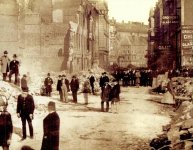
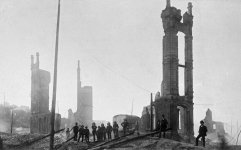
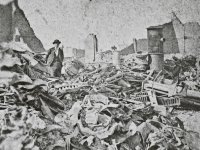
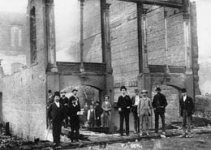
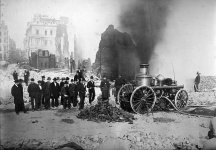
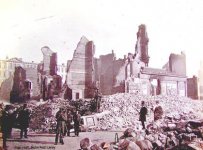
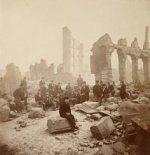
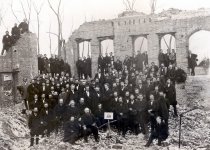
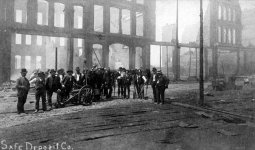
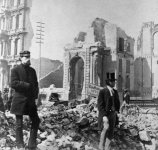
7. Lack of photographic evidence of the clean up activities
8. Super fast rebuilding activities
Nothing demonstrates this better than the following article: 1889 Post-Fire Seattle rebuild speed: 5,625 buildings in 18 months. Look into your own city, there might be a surprise waiting for you there. Additional speedy re-building can be seen here as well: Who nuked San Francisco in 1906? 9. Lack of photographic evidence of the rebuilding activities
There were millions of buildings built in the aftermath of these devastating "urban fires". Where is the photographic evidence of any of those buildings being built? You might find a picture or two of some renovation prepped buildings, but where is that "all the world came together-type" re-building activities?10. Presence of the signs announcing future projects


11. Presence of the non-researchable, dead-end "appointed" architects
Rebuilding had to attract a lot of architects. It sure did. Unfortunately looking into the background of those architects proves to be a dead end. Below are the names and little tiny investigations into four of such architects. They do appear the be some sort of appointed historical figures. They can also be called an investigational dead-end.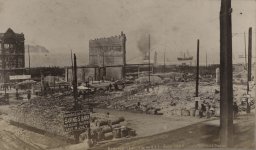
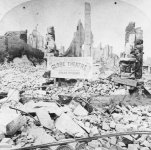
11. Presence of the non-researchable, dead-end "appointed" architects
- Seattle's Elmer H. Fisher: The Man, The Myth, The Legend...
- Jacksonville's architect Henry John Klutho. Who was he, and did he exist?
12. Presence of the non-researchable buildings
The new "re-built" structures are just as much of an enigma, as the entire story. There is a building, there is an architect, and there is nothing else. There won't be any additional information pertaining to the construction of those newly constructed building, meant to replace the burnt ones. Obviously I can not vouch for every single one out there, but I looked into quite a few, and failed to locate any documents pertaining to construction: supply, delivery, blueprints, factories used, payroll, etc. Below are the buildings I wrote articles on. There were 10-15 more I looked into. You can try and do a research of your own using a building near you.13. Bizarre fire initiating stories
Most of these fires start with some ridiculous situations, like the one in the image below, which became an urban legend, because of how stupid it sounds.Cow started the Great Chicago Fire of 1871

In Seattle it was water on some glue, in Jacksonville some sparks from a chimney put Spanish Moss on fire. Of course some fires started in a more conventional way, and several are blamed on wars. The aftermath was always the same - destruction of the antique buildings.
List of the "Fires" I put together
(the below list probably includes less than 10% of the "fires")
(the below list probably includes less than 10% of the "fires")
While it would be interesting to add up all the destroyed buildings, I am not going to dedicate my entire life to this cause1755 - Great Fire of Lisbon, w/ Earthquake and Tsunami
1788 - Great Fire of New Orleans
1794 - Great Fire of New Orleans
1796 - Great Savannah Fire, GA
1802 - Portsmouth City Fire
1805 - Great Fire of Detroit
1808 - Great Fire of Trinidad
1810 - Charleston, SC
1811 - Great fire of Podil
1811 - Great Newburyport fire
1813 - Great Portsmouth Fire
1814 - Great fire of Tirschenreuth, Ger
1815 - Great Fire of Petersburg, Virginia
1817 - Great Sag Harbor Fire
1817 – Great Fire of Saint John’s, Newfoundland, CA
1818 - Great Fire of Salzburg, Austria
1819 - Great Schenectady Fire
1820 - Great Savannah Fire, GA
1822 - Great Fire of Canton, China
1824 - Great Fire of Edinburg, GB
1825 - City fire of Saint John, N. B. CA
1826 - Great Fire Kempston, Bedford, Peterborough, Huntington
1827 - Great Fire of Turku, Finland
1827 - Great Fire of Alexandria, VA, D.C.
1828 - Arita, Saga, Japan
1830 - Great Fire of New Orleans
1831 - Great Fire of Raleigh, NC
1831 - Great Fire of Fayetteville, NC
1833 - 1839 – Fires of Charleston, SC – 1833, 1835, 1835, 1835, 1836, 1837, 1837, 1839, 1839, 1839, 1839, 1839, 1839
1834 - Great fire of the UK Parliament
1834 - City Fire of Syracuse
1835 - Great Fire of New York, NY
1836 - US Patent Office Fire
1837 - City fire of Saint John, N. B. CA
1837 - Great Fire of Southampton, UK
1838 - Great Fire in School Street, IN
1838 - Great Fire of Charleston, SC
1839 - Great Fire of Mobil, AL – 4 separate fires 29 september – 9 october from Athens to bankrupt
1840 - Great Fire of Louisville, KY
1842 - Great Fire of Trondheim, Norway (additional fires 1841, 1842 + 3 more)
1842 – Great Fire of Hamburg, DE
1843 – Great Fire of Kingston, JA
1843 – Great Fire of Tallahassee, FL
1843 – Great Fire of Fall River, MA
1844 – Great Fire of Boston, MA
1844 - Great Fire of Gravesend, UK
1845 – Great Fire of Bridgeport,
1845 – Great Fire of New York, NY
1845 - Great Sag Harbor Fire
1845 – Great Fire of Pittsburgh, PA; destroyed over 1000 buildings
1845 – La Playa (de Ponce), the city port of Ponce, Puerto Rico fire, wiped out most of the Ponce vicinity
1846 – Great Fire of Saint John’s, Newfoundland, CA
1846 – Great Fire of Nantucket, MA
1847 – Great Fire of Bucharest, Romania
1848 – Great Fire of Albany, NY
1848 – Fire in Medina, Ohio. Destroyed the entire business district.
1849 – Great Saint Louis Fire, MO
1849 – First Great Fire of Toronto
1850 - First Great Fire in Philadelphia
1850 - Great Fire of Fredericton
1850 - Great Fire of San Francisco
1851 - Great Fire of San Francisco
1852 – Great Fire of Montreal, CA
1853 - Great Fire at Oswego
1854 - The Great fire of Newcastle and Gateshead
1855 - The Great Fire at Bankside , London
1856 - City Fire of Philadelphia
1857 - First Great Fire in Sandhurst
1858 - Great Fire of Christiania
1861 – Great Charleston Fire, SC
1862 – Troy, New York, 671 buildings destroyed
1863 – Great Fire of Denver, CO
1864 – Great Fire of Brisbane, Queensland, Australia: Over four city blocks burned with over 50 houses razed; 0 deaths, 4 injured
1864 – Atlanta, Georgia, burned after time given for evacuation of citizens by order of William Tecumseh Sherman
1865 – City Fire of Richmond, Virginia, burned by retreating Confederates
1865 – Columbia, South Carolina, burned while being occupied by troops commanded by William Tecumseh Sherman
1866 – Great Fire of Portland, Maine
1868 – Auerbach in der Oberpfalz, Bavaria. Arson destroys 107 houses and 146 other buildings; 4 deaths
1870 – Great Fire of Constantinople, Turkey
1870 – Fire in Medina, Ohio, consumed all but two blocks of the business district, nearly wiping out the entire town
1871 – Great Chicago Fire, IL
1871 – Great Peshtigo Fire, Wisconsin
1871 – Great Urbana Fire, OH
1872 – Great Boston Fire of 1872, destroyed 776 buildings and killed at least 20 people.
1873 – Great Fire of Portland, OR
1874 – City Fire of Chicago, destroyed 812 structures and killed 20 people.
1877 – Saint John, New Brunswick Fire destroyed 1600 buildings
1878 – The Great Fire of Hong Kong, destroyed 350 to 400 buildings across more than 10 acres of central Hong Kong.
1879 – Hakodate fire, Hakodate, Hokkaidō, Japan, 67 fatalities, 20,000 homeless
1881 – Thumb Fire in Michigan
1881 – Ringtheater fire in Vienna, Austria
1886 – Great Vancouver Fire, Vancouver, British Columbia
1887 - Cannon Falls Fires, MN
1889 – Great Fire of Spokane, WA
1889 – Great Bakersfield Fire - destroyed 196 buildings and killed 1 person
1889 – Great Fire of Seattle, WA
1889 – The First Great Lynn Fire, Lynn, Massachusetts - destroyed about 100 buildings
1891 – Great Fire of Syracuse
1892 – Great Fire of Saint John’s, Newfoundland, CA
1893 – City Fire of Clarksville, Virginia.
1894 - Great Hinckley Fire
1894 – Great Fire in Shanghai; over 1,000 buildings are destroyed
1896 - Great Fire of Paris, Texas; destroyed much of the town
1897 - The Great Fire of Windsor, Nova Scotia Canada, destroyed 80% of the town
1898 - Great Fire of New Westminster, British Columbia
1898 - Great fire of Park City, Utah
1906 – Great SF Fire and Earthquake
1914 – Great Salem Fire, MA – 1376 bldgs
1918 - Cloquet, Duluth, and Moose Lake Fires
SUMMARY: while we are being told that mostly wooden structures were damaged, or destroyed, photographic evidence (whatever little we have) suggests otherwise. It is notable that structures destroyed look very similar to the ones in the article "Similar style buildings are all over the world. Were they built by our civilization?" It is hard to imagine that it took our civilization 150 years to figure out that wood burns. At the same time today's residential districts in the United States are nothing but plywood.
Separately, the so-called "Urban Fire" damages raise questions. I personally still want to know what "fire" was able to cut three of the below blocks in half.
Could Herbert George Wells know something back in 1897? What about Mike Brunton in 2015?


